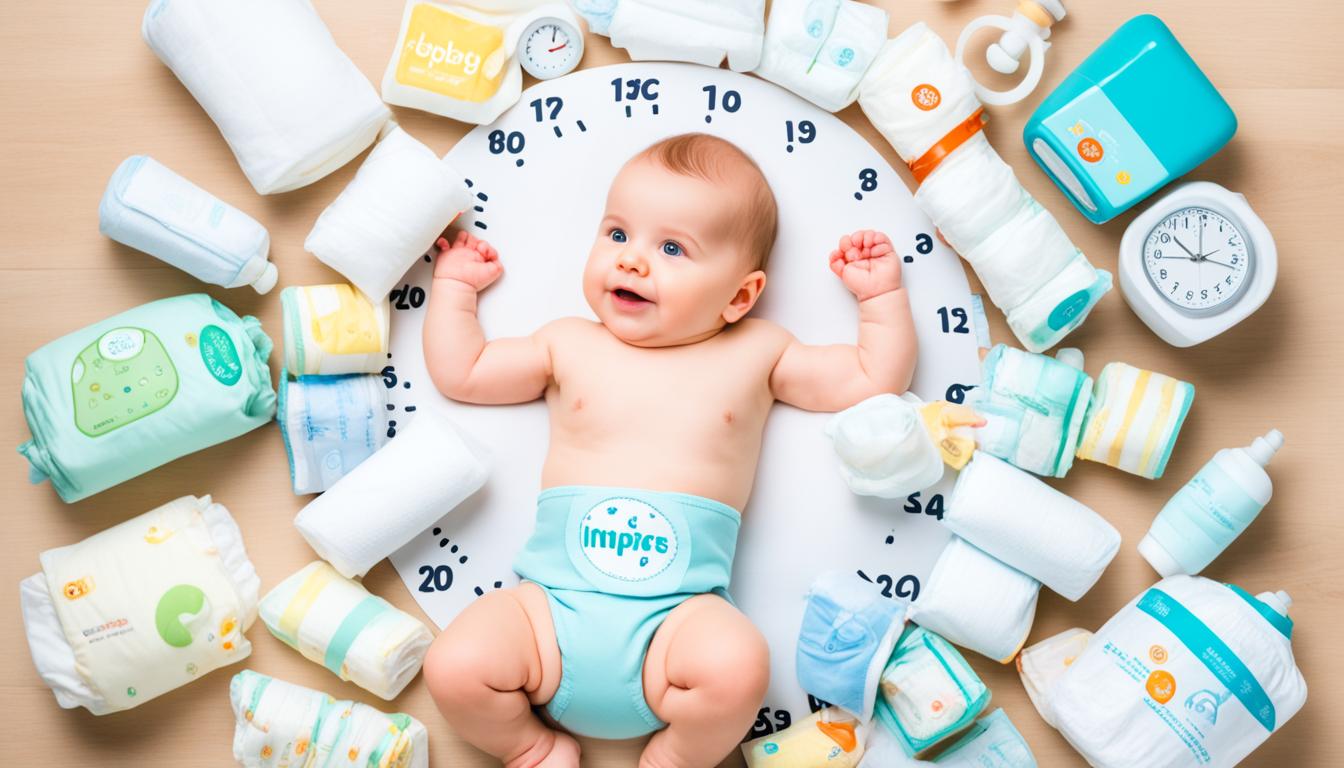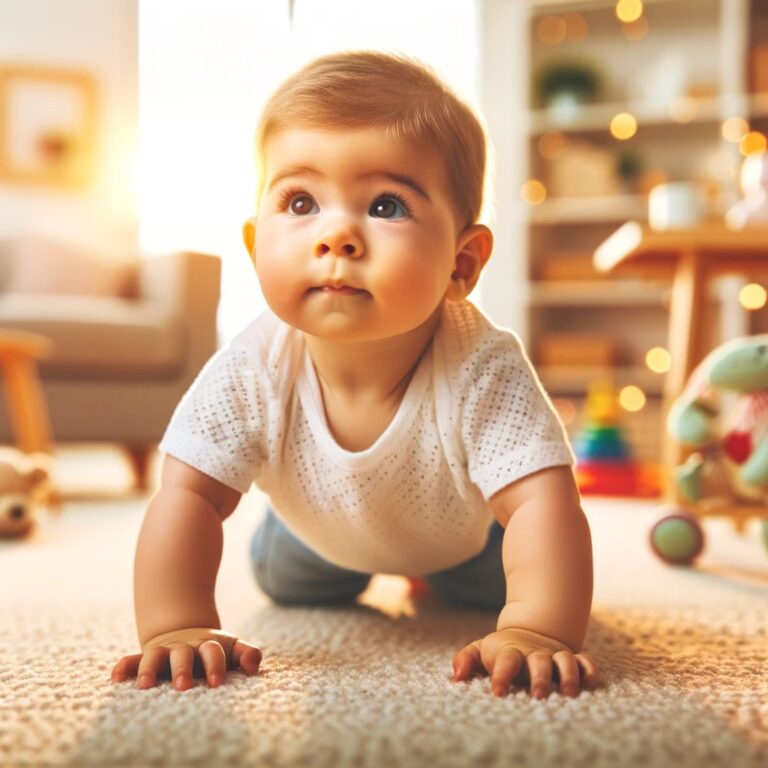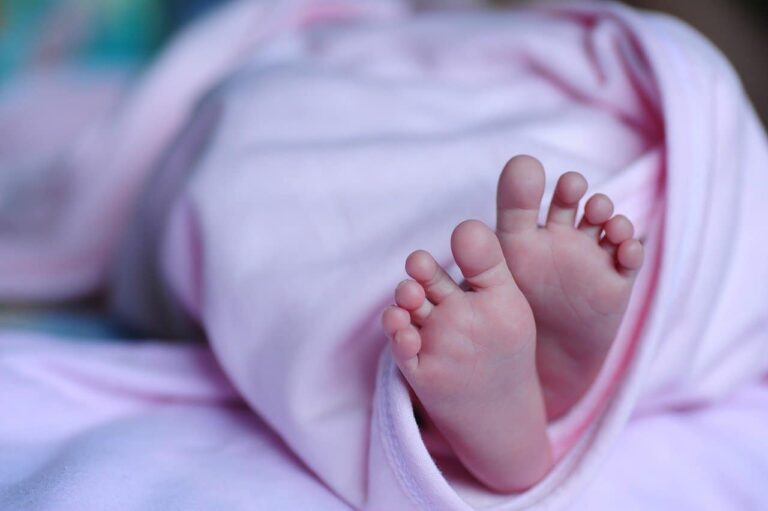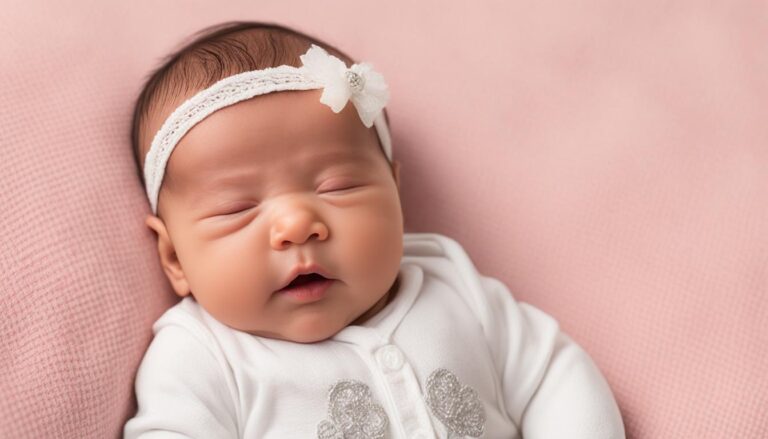Diaper Change Frequency: How Often To Change Baby Diaper
One of the first things new parents learn is that diaper changes become a regular part of their daily routine. But have you ever wondered how often you should actually be changing your baby’s diaper? Is it every hour, every two hours? Maybe even less frequently? In this article, I’ll unravel the mystery behind diaper change frequency and provide you with the essential information you need to keep your baby clean, comfortable, and smiling.
When it comes to diaper changes, there’s no one-size-fits-all answer. The frequency depends on various factors such as your baby’s age, their feeding habits, and the type of diaper you’re using. By understanding these factors and following some essential guidelines, you’ll be equipped to make the best choices for your little one.
Skip To The Following Sections
- How Often To Change a Newborn’s Diaper
- How Often To Change a Newborn’s Diaper at Night
- How Often To Change a Baby’s Diaper After Introducing Solids
- Diaper Changing Tips
- How Often To Clean Baby During Diaper Change
- Age and Excretion Frequency for Diaper Changes
- Importance of Timely Diaper Changes
- Diaper Changes for Cloth Diaper Users
- Timing of Diaper Changes with Feeding
- Diaper Changes During Sleep
- Importance of Baby Wipes in Diaper Changes
- FAQ
- How often should I change my baby’s diaper?
- How often should I change a newborn’s diaper?
- How often should I change a newborn’s diaper at night?
- How often should I change my baby’s diaper after introducing solids?
- What are some diaper changing tips?
- How often should I clean my baby during a diaper change?
- Does the frequency of diaper changes depend on the age of the baby?
- Why are timely diaper changes important?
- How often should cloth diapers be changed?
- When is the best time to change a diaper in relation to feeding?
- Should I change my baby’s diaper during sleep?
- How important are baby wipes in diaper changes?
Key Takeaways:
- Diaper change frequency varies based on factors such as age, diaper type, and feeding habits.
- For newborns, it is recommended to change diapers every two to three hours or as needed.
- Regular diaper changes are crucial to prevent diaper rash, skin irritation, and bladder infections.
- During night-time, diaper changes can be less frequent if the diaper is not excessively wet.
- Cloth diapers require more frequent changes compared to disposable diapers.
How Often To Change a Newborn’s Diaper
When it comes to diaper changes for newborns, establishing a regular diaper changing schedule is essential. Newborns have unique diapering needs and require frequent diaper changes to ensure their comfort and hygiene. Here are some guidelines to help you navigate the world of newborn diaper changes:
1. Change diapers every two to three hours or as needed:
Newborns have a faster metabolism, which means they urinate more frequently and have more bowel movements compared to older babies. On average, newborns may urinate every one to three hours and have between two and five bowel movements a day. Changing their diapers every two to three hours or as needed helps prevent diaper rash, skin irritation, and bladder infections.
2. Change diapers before or during feedings:
Adding diaper changes to your baby’s feeding routine can be helpful in establishing a diaper changing schedule. By changing their diapers before or during feedings, you ensure that their diaper is clean and dry, allowing them to focus on their meal comfortably.
3. Be prepared with all the necessary supplies:
Gather all your diapering essentials before starting each diaper change. This includes clean diapers, wipes, a changing pad, and any diaper rash ointment if needed. Being well-prepared ensures a smooth and efficient diaper changing experience for both you and your baby.
4. Keep an eye out for signs of discomfort:
While following a regular diaper changing schedule is important, it’s equally important to be attentive to your baby’s needs. If your newborn displays signs of discomfort, such as fussiness or prolonged crying, check their diaper. They may need a diaper change even if it falls outside the usual schedule.
With these tips in mind, you’ll be able to establish a diaper changing routine that keeps your newborn clean, dry, and comfortable. Remember, every baby is unique, so adapt the diaper changing schedule based on your baby’s individual needs.
How Often To Change a Newborn’s Diaper at Night
When it comes to nighttime diaper changes for newborns, the frequency can be adjusted based on their wetness. If the baby is not overly wet, it is generally safe to let them sleep without changing the diaper. This can help minimize disruptions during the night and promote uninterrupted sleep for both the baby and parents. However, it is important to note that soiled diapers should always be changed to prevent discomfort and the risk of diaper rash.
To ensure a comfortable and leak-free sleep, it is recommended to use nighttime diapers with high absorbency. These diapers are designed to keep the baby dry and comfortable for longer periods, reducing the need for frequent changes throughout the night. Nighttime diapers often have enhanced leakage protection and are capable of absorbing more liquids, providing the baby with a peaceful and undisturbed sleep.
By using nighttime diapers with high absorbency, parents can rest assured that their little one will stay dry and comfortable through the night. This allows everyone to get the rest they need, promoting a well-rested and happy family.
How Often To Change a Baby’s Diaper After Introducing Solids
As your baby grows and starts consuming solid foods, you may notice a change in their diaper changing routine. The frequency of diaper changes may decrease, but it’s still essential to ensure your baby’s comfort and hygiene. Here are some diaper changing guidelines to follow after introducing solids:
- Check the diaper every few hours: Even though the frequency of diaper changes may decrease, it’s important to regularly check the diaper every few hours. This will help ensure that your baby is not sitting in a wet or soiled diaper for an extended period.
- Change every soiled diaper: Regardless of whether your baby is on a solid food diet or not, it’s crucial to change every soiled diaper promptly. This helps prevent skin irritation, diaper rash, and potential infections.
- Consider your baby’s activity level: Active and mobile babies may require more frequent diaper changes to avoid messy situations. Pay attention to your baby’s cues, such as discomfort or restlessness, to determine when a diaper change is needed.
Remember, every baby is different, so it’s important to adapt the diaper changing routine to your baby’s individual needs. By following these diaper changing guidelines, you can ensure your baby stays clean, comfortable, and free from diaper-related issues.
Diaper Changing Routine Tips
Here are a few additional tips to help you establish a smooth diaper changing routine:
- Always have the necessary supplies on hand, including clean diapers, wipes, and diaper rash ointment.
- Choose a comfortable and safe changing area for your baby. Use a changing pad or towel to provide a clean and soft surface.
- Gently clean your baby’s diaper area using wipes or a damp cloth. Pat dry before putting on a fresh diaper.
- Apply a thin layer of diaper rash ointment if your baby’s skin appears irritated or red.
- Safely dispose of soiled diapers and wash your hands thoroughly after each diaper change.
Diaper Changing Tips

When it comes to diaper changing, being prepared and following a step-by-step process can make the experience smoother for both you and your baby. Here are some helpful diaper changing tips:
- Gather all the necessary supplies: Before you start changing your baby’s diaper, make sure you have everything you need within reach. This includes clean diapers, wipes, a changing pad, and diaper rash ointment if needed.
- Create a designated changing area: Having a dedicated space for diaper changes can make the process more organized and convenient. Set up a changing station with all the essentials for easy access.
- Follow the step-by-step process: When changing your baby’s diaper, it’s important to follow a consistent routine. Here’s a simple step-by-step process to help you:
Step 1: Remove the used diaper
Begin by gently opening the dirty diaper and folding it closed, using the tabs to secure it. Place it aside or dispose of it in a diaper pail.
Step 2: Clean the baby’s diaper area
Use baby wipes or a damp cloth to gently clean your baby’s genital area. Wipe from front to back to prevent any potential infection. Make sure to clean all the folds and creases.
Step 3: Apply diaper rash ointment (if needed)
If your baby has diaper rash or is prone to irritation, apply a thin layer of diaper rash ointment to protect their delicate skin.
Step 4: Properly fasten the new diaper
Position a clean diaper under your baby, making sure the back is higher than the front. Bring the front of the diaper up between your baby’s legs and secure the tabs snugly around their waist. Ensure the diaper is not too tight or too loose.
By following these diaper changing tips, you can ensure a safe and comfortable experience for your baby while maintaining good hygiene.
| Supplies needed for diaper changes |
|---|
| Clean diapers |
| Wipes |
| Changing pad |
| Diaper rash ointment (if needed) |
How Often To Clean Baby During Diaper Change
When it comes to maintaining your baby’s hygiene during diaper changes, regular cleaning is essential. As a parent, you may wonder how often you should clean your baby during diaper changes. The frequency of diaper changes depends on various factors, including the type of diaper and your baby’s individual needs.
For optimal hygiene, it is generally recommended to change diapers every 2-3 hours. This ensures that your baby stays clean and comfortable throughout the day. However, immediate diaper changes are necessary when your baby defecates, as leaving them in a soiled diaper can lead to skin irritations and infections.
The type of diaper you use can also impact the frequency of changes. Muslin cloth diapers, for example, require more frequent changes as they do not retain liquids as well as disposable diapers. On the other hand, disposable diapers with high absorbency can extend the time between changes. However, it is still important to change them promptly to prevent diaper rash, dermatitis, and urinary tract inflammation.
Here is a summarized comparison:
| Diaper Type | Frequency of changes |
|---|---|
| Muslin cloth diapers | Every 1-2 hours |
| Disposable diapers | Every 2-3 hours |
| Disposable diapers with high absorbency | Can be extended to 3-4 hours |
Remember, maintaining your baby’s cleanliness is crucial for their health and well-being. By following these recommended guidelines for diaper cleaning frequency, you can help prevent diaper-related issues and ensure your little one stays happy and comfortable.
Quote:
“Regular diaper changes are essential for maintaining your baby’s cleanliness and preventing diaper-related issues.” – Dr. Emma Johnson
Age and Excretion Frequency for Diaper Changes
The frequency of diaper changes depends on the age of the baby. Newborns typically have more frequent bowel movements and urination. As they grow older, the rate of excretion decreases. Babies between 1 month and 12 months will have varying rates of excretion based on their feeding habits. Babies 12 months and older have excretion frequencies that resemble adults. Parents should adapt diaper changes to meet the baby’s individual needs and maintain good hygiene.
When babies are newborns, they have immature digestive and urinary systems, resulting in frequent excretion. This means they may require diaper changes every two to three hours or even more frequently. It’s important to keep newborns clean and dry to avoid diaper rash and discomfort. As babies grow older, their excretion rate tends to decrease, and diaper changes can be adjusted accordingly.
From 1 month to 12 months, the excretion frequency varies depending on the baby’s feeding habits. Breastfed babies tend to have more frequent bowel movements and may require more frequent diaper changes compared to formula-fed babies. This is because breast milk is easily digested, resulting in more waste production. Formula-fed babies, on the other hand, may have fewer bowel movements but may urinate more frequently, especially if they consume larger quantities of formula.
Once babies reach the age of 1 year or older, their excretion frequencies become more similar to those of adults. They usually have regular bowel movements and urination patterns, making it easier for parents to establish a diaper changing routine. However, it’s essential to note that individual variations may still exist, and some babies may have higher or lower excretion rates.
Excretion Frequency Based on Age
| Age | Bowel Movements | Urination | Diaper Change Frequency |
|---|---|---|---|
| Newborn | Frequent (up to 10 times a day) | Frequent (every 1 to 3 hours) | Every 2 to 3 hours or as needed |
| 1 month to 12 months | Varies based on feeding habits | Varies based on feeding habits | Customized based on individual needs |
| 12 months and older | Regular bowel movements | Similar to adults | Customized based on individual needs |
It’s important for parents to pay attention to their baby’s excretion patterns and adjust diaper changes accordingly. Regular diaper changes help maintain good hygiene, prevent discomfort, and reduce the risk of diaper-related problems such as diaper rash and infections. By understanding the age-related diaper changes and excretion frequency, parents can provide optimal care for their baby’s diapering needs.
Importance of Timely Diaper Changes
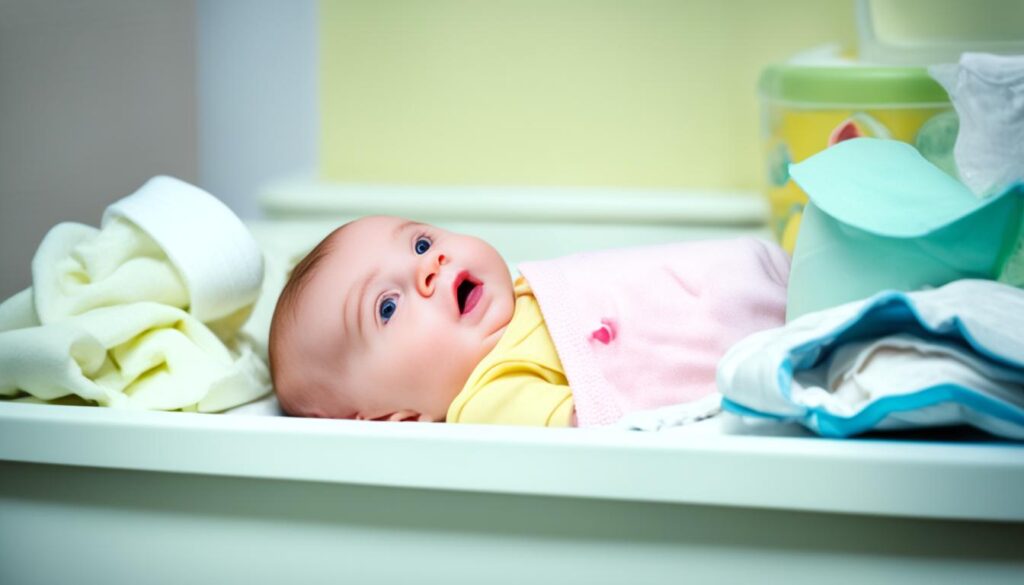
As a parent, one of the most important tasks is ensuring the health and hygiene of your baby. Timely diaper changes play a crucial role in maintaining their well-being and preventing various diaper-related problems.
Delayed diaper changes can lead to a range of issues that can cause discomfort and irritation for your little one. Let’s take a closer look at some of the problems that can arise:
- Diaper Rash: Prolonged exposure to urine and feces can cause diaper rash, a common skin condition characterized by redness, inflammation, and discomfort. Regular diaper changes help keep your baby’s skin dry and prevent the development of diaper rash.
- Skin Chafing: Friction between wet diapers and delicate baby skin can lead to chafing, resulting in redness, soreness, and discomfort. Changing the diaper promptly reduces the risk of chafing and keeps your baby’s skin soft and healthy.
- Infections: Moist environments created by prolonged diaper use can provide an ideal breeding ground for bacteria and yeast infections. By changing diapers in a timely manner, you can prevent the occurrence of these infections and keep your baby’s skin free from harmful microorganisms.
- Digestion Tracking Issues: Regular diaper changes allow you to monitor your baby’s bowel movements and urinary patterns, providing valuable insights into their digestive health. Identifying changes in the frequency or consistency of bowel movements can help detect possible gastrointestinal issues early on.
- Leakage and Diaper Breakage: Overly saturated diapers are prone to leaks and breakage, resulting in messes and discomfort for your little one. Changing diapers frequently ensures a snug fit and prevents leakage, keeping your baby dry and comfortable.
- Odor and Bacterial Growth: Leaving diapers on for long periods can cause unpleasant odors and allow bacteria to grow. Regular diaper changes help maintain a fresh and clean environment, minimizing the risk of odor and bacterial contamination.
By understanding the importance of timely diaper changes, you can prioritize your baby’s comfort, health, and well-being. Make sure to establish a routine and check their diaper frequently to ensure they stay clean, dry, and happy.
“Regular diaper changes are essential for preventing diaper rash, infections, and other discomforts that can affect your baby’s health and happiness.”
Now that you know the importance of timely diaper changes, let’s explore some helpful tips and strategies to make diaper changing a breeze.
Diaper Changes for Cloth Diaper Users
When it comes to cloth diaper changes, it’s important to understand that they require more frequent attention compared to disposable diapers. This is because cloth diapers have lower absorbency levels, meaning they may not hold as much liquid as disposable options. To maintain good hygiene and prevent discomfort for your baby, it is recommended to change cloth diapers approximately every 90 minutes.
In addition to the more frequent changes, cloth diapers also require some extra care and maintenance. Unlike disposables, which can simply be thrown away, cloth diapers need to be cleaned and reused. This involves additional steps such as washing and, in the case of solid waste, scooping the poop before washing.
Despite the added effort, there are benefits to using cloth diapers. Not only do they help reduce waste and minimize environmental impact, but they can also provide cost savings compared to disposable alternatives in the long run.
Factors to Consider When Using Cloth Diapers
Before diving into the world of cloth diaper changes, there are a few factors to consider:
- Number of diapers needed: Since cloth diapers require more frequent changes, you may need to invest in a larger quantity compared to disposable diapers.
- Cleaning routine: It’s important to establish a washing routine that keeps your cloth diapers hygienic and eliminates any odors or staining.
- Diaper cover options: Cloth diapers often require a separate waterproof cover to prevent leaks. There are various cover types available, such as pocket diapers and fitted diapers, so it’s essential to find the style that works best for you and your baby.
| Advantages of Cloth Diapers | Disadvantages of Cloth Diapers |
|---|---|
|
|
While cloth diaper changes may require a bit more effort, many parents find them to be a worthwhile choice. By understanding the necessary frequency of changes and establishing a proper cleaning routine, you can successfully navigate the world of cloth diapers and provide a comfortable and eco-friendly diapering solution for your little one.
Timing of Diaper Changes with Feeding
When it comes to diaper changes, the timing in relation to feeding can vary based on personal preference and convenience. Some parents prefer to change their baby’s diaper before or during feedings to ensure a clean and comfortable experience for both the baby and themselves.
Changing the diaper before a feeding can help create a calm and uninterrupted environment for the baby to enjoy their meal. It allows them to settle down and relax after the feeding without any interruptions or discomfort caused by a wet or soiled diaper. Additionally, changing the diaper before a feeding can help in establishing a routine and signal to the baby that it’s time to eat.
On the other hand, changing the diaper during a feeding can be a practical choice as it combines both tasks and saves time. It can also be helpful for babies who have a strong urge to urinate or have a bowel movement during or immediately after a feeding. By changing the diaper during the feeding, it minimizes the chances of a messy situation or discomfort for the baby.
However, it’s important to note that if the baby does have a bowel movement after a feeding, it is crucial to change the diaper immediately. This ensures that the baby stays clean, dry, and comfortable, reducing the risk of diaper rash and skin irritation.
“Changing the diaper before or during a feeding depends on personal preference and convenience, but it’s essential to prioritize cleanliness and the baby’s comfort.”
Benefits of Diaper Changes Before or During Feedings
There are several benefits to changing the diaper before or during feedings:
- Allows the baby to sleep without interruption after a feeding
- Creates a calm and relaxed environment for feeding
- Helps establish a routine for both feeding and diaper changes
- Saves time by combining two tasks
- Minimizes the chances of messy situations caused by bowel movements during or after a feeding
Pros and Cons of Diaper Changes Before or During Feedings
| Benefits | Considerations |
|---|---|
| Allows uninterrupted sleep after a feeding | May interrupt feeding if the baby needs a diaper change during |
| Creates a calm and relaxed feeding environment | May require additional time and effort if the baby has a bowel movement during the feeding |
| Establishes a routine for feeding and diaper changes | May not be suitable for babies who prefer to have a fresh diaper before feeding |
| Saves time by combining tasks | May not work well if the baby has a strong urge to urinate or defecate during a feeding |
| Minimizes the chances of messy situations | Requires immediate attention if the baby has a bowel movement after a feeding |
Diaper Changes During Sleep
When it comes to diaper changes during sleep, there are a few things to consider. Generally, it is acceptable to let the baby sleep without changing the diaper if it only contains urine. This is because modern diapers are designed with high absorbency to keep the baby dry and comfortable throughout the night.
However, if the diaper contains a bowel movement, it is important to change it immediately. Bowel movement diapers can cause discomfort and may lead to skin irritation if left unchanged for an extended period of time.
To ensure a peaceful and uninterrupted sleep, it is recommended to use nighttime diapers with high absorbency. These diapers are specially designed to prevent leaks and provide maximum comfort during sleep. They can help keep both the baby and parents happy by reducing disruptions in the middle of the night.
The same rules for nighttime diaper changes can also apply to long naps during the day. If your baby is taking a long nap, you can let them complete their sleep session before changing the diaper, as long as it only contains urine. This allows them to get the rest they need without unnecessary interruptions.
Importance of Baby Wipes in Diaper Changes
Baby wipes are an essential tool in every parent’s diaper changing routine. These wipes not only ensure proper cleanliness and hygiene but also provide a convenient and efficient way to clean up after diapering. When it comes to choosing the right wipes for your baby, there are a few key factors to consider.
First and foremost, it is important to use wipes after every bowel movement and when your baby’s skin is soaked in urine. This helps to prevent irritation, rashes, and infections. Look for wipes that are gentle on your baby’s delicate skin, free from harsh chemicals, and fragrance-free to minimize the risk of allergic reactions.
One brand that meets all these criteria is Doctor Butler’s Organic Baby Wipes. These wipes are specially designed to be gentle, soothing, and fragrance-free, making them ideal for babies with sensitive skin. Plus, their thick and durable texture ensures effective and efficient cleaning, so you can spend less time on diaper changes and more time enjoying precious moments with your little one.
By using the right baby wipes, you can ensure that your baby stays clean, comfortable, and protected during diaper changes. So, make sure to choose wipes that meet the highest standards of quality and safety, like Doctor Butler’s Organic Baby Wipes. Your baby’s bottom will thank you!
FAQ
How often should I change my baby’s diaper?
It is recommended to change a newborn’s diaper every two to three hours or as often as needed. Diaper changes should be adjusted as the baby grows older and their diapering needs change.
How often should I change a newborn’s diaper?
Newborns should have their diapers changed every two to three hours or as needed. Regular diaper changes are important to prevent diaper rash, skin irritation, and bladder infections.
How often should I change a newborn’s diaper at night?
The frequency of diaper changes at night can be adjusted depending on the baby’s wetness. If the baby is not overly wet, it is generally safe to let them sleep without changing the diaper.
How often should I change my baby’s diaper after introducing solids?
As the baby grows and starts consuming solid foods, the frequency of diaper changes may decrease. However, it is still important to check the diaper every few hours to ensure the baby is not too wet. A diaper change is required with every soiled diaper.
What are some diaper changing tips?
Some helpful diaper changing tips include gathering all the necessary supplies before starting, having a designated area for diaper changes, and following a step-by-step process of removing the used diaper, cleaning the baby’s diaper area, applying diaper rash ointment if needed, and properly fastening the new diaper.
How often should I clean my baby during a diaper change?
Diapers should be changed every 2-3 hours to maintain the baby’s hygiene. Immediate diaper changes are necessary when the baby defecates. Baby wipes play a crucial role in ensuring proper cleanliness and hygiene during diaper changes.
Does the frequency of diaper changes depend on the age of the baby?
Yes, the frequency of diaper changes depends on the age of the baby. Newborns typically have more frequent bowel movements and urination. As they grow older, the rate of excretion decreases. Parents should adapt diaper changes to meet the baby’s individual needs.
Why are timely diaper changes important?
Timely diaper changes are crucial for the baby’s health and hygiene. Delayed diaper changes can lead to various problems, including diaper rash, skin irritation, infections, leakage, and discomfort for the baby.
How often should cloth diapers be changed?
Cloth diapers require more frequent changes compared to disposable diapers due to their lower absorbency. On average, cloth diapers should be changed every 90 minutes to maintain good hygiene.
When is the best time to change a diaper in relation to feeding?
The timing of diaper changes in relation to feeding depends on personal preference and convenience. Many parents choose to change diapers before or during feedings to allow the baby to sleep after a feeding without interruption. However, if the baby has a bowel movement after a feeding, the diaper should be changed immediately.
Should I change my baby’s diaper during sleep?
It is generally acceptable to let the baby sleep without changing the diaper if it only contains urine. However, bowel movement diapers should be changed immediately. Nighttime diapers with high absorbency can help prevent leaks and discomfort during sleep.
How important are baby wipes in diaper changes?
Baby wipes play a crucial role in diaper changes by ensuring proper cleanliness and hygiene. Using the right wipes, such as Doctor Butler’s Organic Baby Wipes, can make diaper changes more comfortable and efficient for both the baby and the parents.

